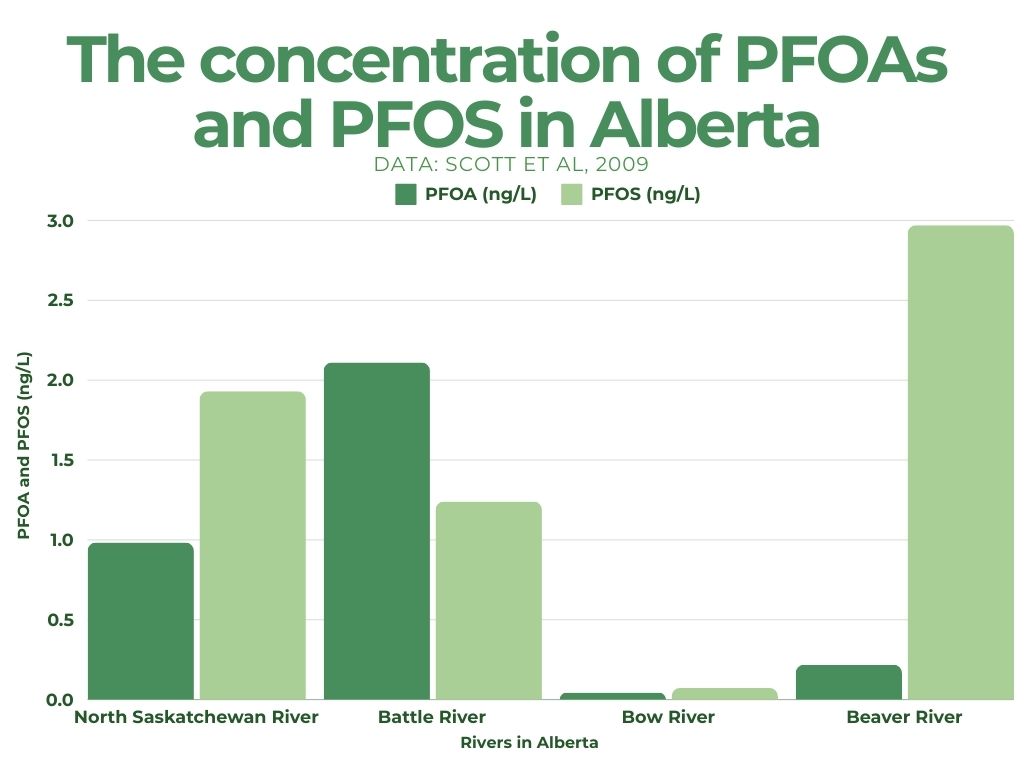
What’s in the Water? How Forever Chemicals Linger
August 9, 2024
- •
- •
- •
Alberta’s drinking water is not free of these.
By Radhika Thekke Kuruvath
Read the PDF version here.
Many of you have heard about PFAS (Perfluoroalkyl substances), man-made chemicals that are considered hazardous to people, especially at higher exposure levels. Perfluorooctanoic acid (PFOA), a major member of the PFAS family, is considered carcinogenic by the International Agency for Research on Cancer at high levels of exposure, but non-cancerous at lower levels.
Alberta’s drinking water is not free of these. While there don’t seem to be high levels in our waterways now, very little research has been conducted in Alberta’s watersheds to measure PFAS concentrations.
Exposure pathways
PFAS are present in a wide variety of environments globally including soil, air, drinking water, rivers, lakes, wastewater effluents, and groundwater. Alberta is no exception. These chemicals are highly persistent and can bioaccumulate which makes them more harmful. Their water- and oil-repelling properties make them useful in manufacturing non-stick cookware, raincoats, food packaging, industrial surfactants, aqueous fire-fighting foams, drilling fluids and more, according to research by Bolan et.al, 2007. In other words, they are abundant in our society.
These chemicals not only affect the immediate area of exposure but also can be carried longer distances through surface runoff, into rivers, lakes, and the sea. Their percolation and infiltration into subsoil can reach the water table and affect groundwater. Chemicals that belong to the family of PFAS are capable of long-range transport as they are not susceptible to environmental degradation, affecting soil, water, and air along their route (Benott and Christine, 2022). PFOAs with longer carbon chains tend to bioaccumulate more and have a greater toxicity effect.
Impact on human health and aquatic species
The spectrum of carcinogenicity is a factor when considering the maximum allowable concentration in drinking water. The type of PFAS also impacts permitted concentrations; for example, the maximum allowable concentration of Perfluorooctanoic acid (according to the federal government’s standard) is 200 ng/L while Perfluorooctane sulfonate (PFOS) is 600 ng/L (Health Canada, 2018).
Humans often detected with high levels of PFAS are those working with PFAS manufacturing facilities and firefighters. Notably high levels of PFAS in the blood and serum of these people have been confirmed by human bio-monitoring studies. The short carbon chain PFAS are often excreted through urine while the long carbon chain PFAS show a steady state concentration in the human body, according to Health Canada. PFAS present in breastfeeding mothers can be transferred through milk to infants, which may lead to decreased immunity in infants. A study conducted by Michelle et al., 2010 on 252 pregnant women in Edmonton found that 91 percent of the samples were above the detection limit. In addition to cancer, PFAS may negatively affect the liver, kidney, central nervous system, thyroid, and reproductive system.
Recent studies by Wenqian et al. (2023) show the bioaccumulation of these substances in marine algae affects their photosynthesis and ultimately their growth. These algae play a major role in the marine food web and can affect species in higher trophic levels. Biomagnification is also noticed as these chemicals tend to be present more in the species higher up in the food chain. The growth and reproduction of aquatic invertebrates are also affected by PFAS exposure, according to Health Canada. Moreover, the water solubility of PFAS depends on the length of the carbon chain which in turn affects its accumulation rate in the species.
PFAS in Alberta
PFOA and PFOS are major groups that belong to the family of PFAS. Elevated concentrations of PFOS are found downstream near airports due to the greater usage of aqueous film-forming foams (AFFFs). Several Albertan airports and military bases were confirmed or suspected to have PFAS contamination present, according to the Canadian Environmental Law Association, 2023. Confirmed sites include the airports in Fort McMurray and Calgary along with the military bases of 4 Wing Cold Lake (site-wide), Wainwright (site-wide) and CFB Edmonton (site-wide). The Edmonton Airport, meantime, is suspected to have PFAS.
In one study by Brian Scott et al., published in 2009 in the Water Quality Research Journal, the concentration of PFAS in the upstream portion of the North Saskatchewan River was less than in the downstream portion. Among these, the samples from Wascana Creek, Saskatchewan, which at the time received wastewater treatment effluent from Regina, had the highest PFOS concentration. PFOA was detected in effluent wastewater treatment facilities at concentrations ranging from 0.007 to 0.055 μg/L in Canada, according to 2012 federal government data.
While the levels of PFOA and PFOS in these Albertan rivers were below the maximum acceptable concentration in 2009, continued monitoring is required to avoid negative consequences from high concentrations. Moreover, PFAS are not regularly monitored at drinking water treatment plants in Alberta and changes in concentrations may have occurred since 2009.
PFAS regulation in Alberta
PFAS are included in a class of Toxic Substances under the Canadian Environmental Protection Act (1999). This legislation is meant to control the manufacturing, research and development, transport and disposal of these substances, as well as to minimize their use in firefighting foams. Soil and groundwater quality guidelines were released by Health Canada in 2019. The guidelines set the maximum allowable concentrations of PFOA in drinking water at 0.0002mg/L, for PFOS it is 0.0006mg/L. Alberta also released Tier 1 Soil and Groundwater Remediation Guidelines on how to remediate the site contaminated with these chemicals.
In May 2023, the Draft State of Per- and Polyfluoroalkyl Substances (PFAS) Report was released by Health Canada where they are planning to include the PFAS as a class rather than as individual substances. The report gives the sources, fate, and potential impacts of PFAS on the environment and human health to inform decision-making on PFAS in Canada. Federal regulations on PFAS as a class are yet to come. Alberta issued soil guidelines in January 2023 for PFOS and groundwater guidelines for PFOS and PFOA.
Above all, these deleterious chemicals need to be regularly monitored and removed (not done by conventional water treatment plants) from the water to avoid negative impacts on ecosystems and human health.

